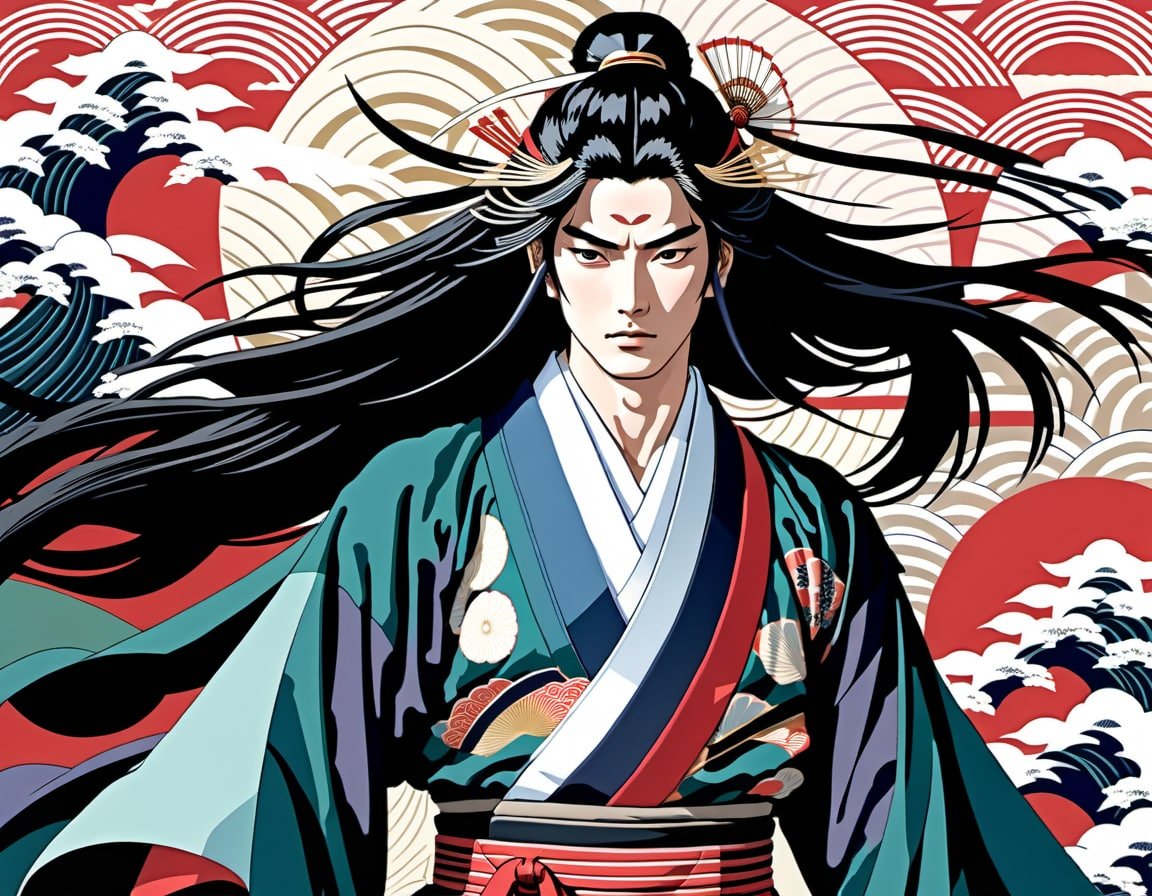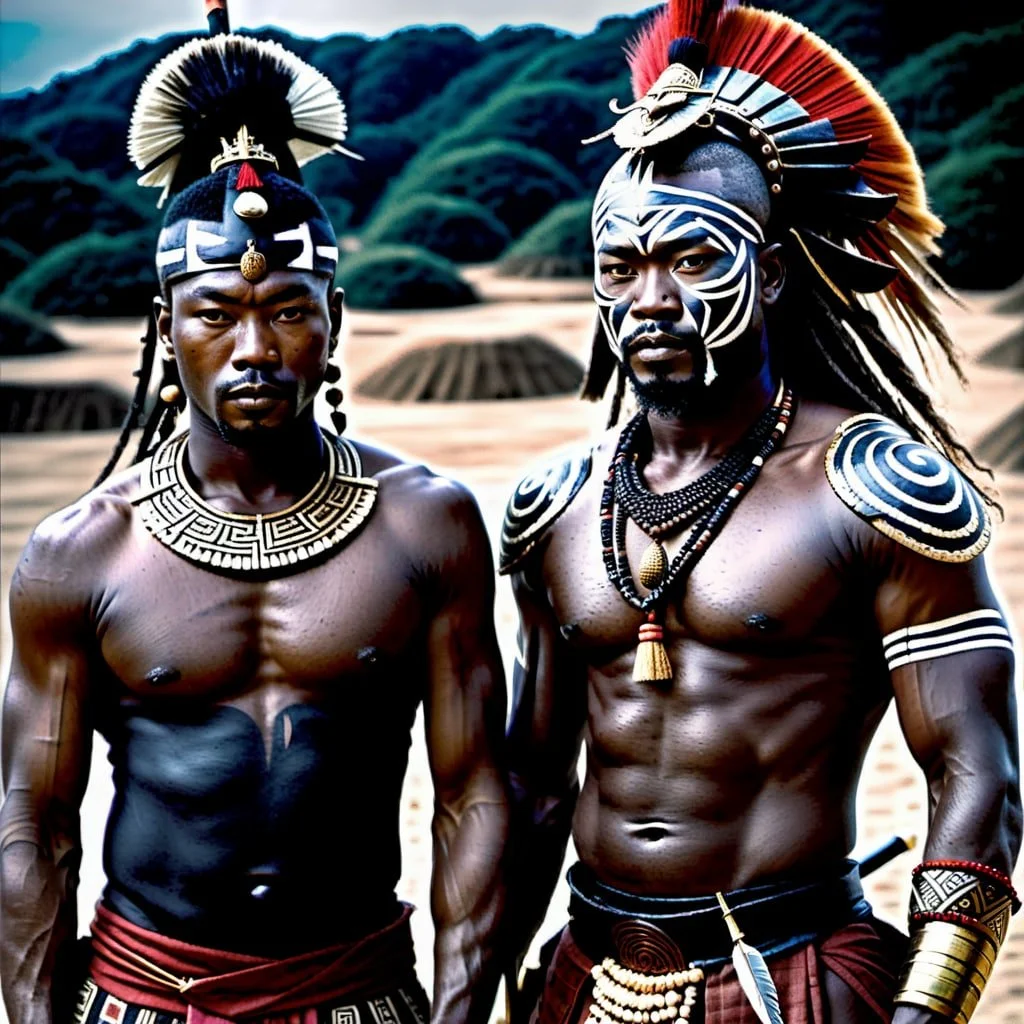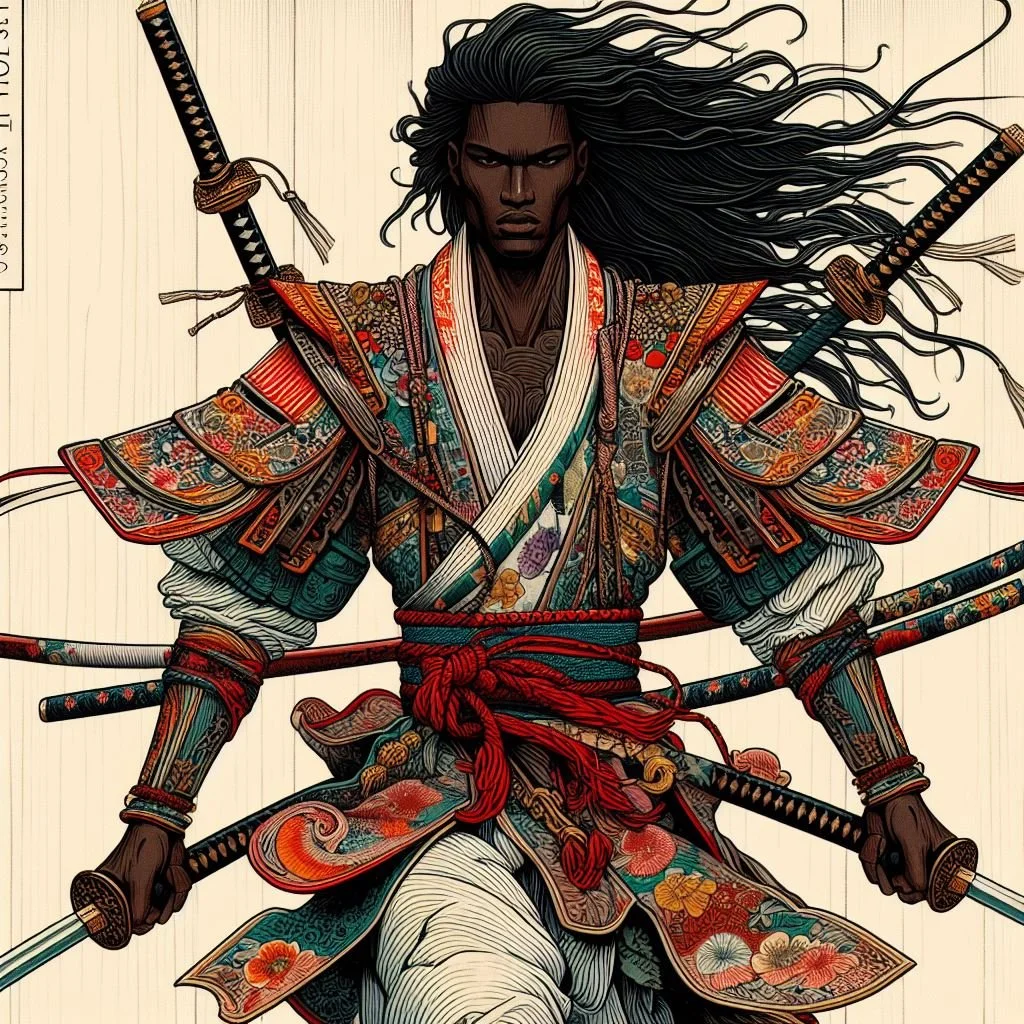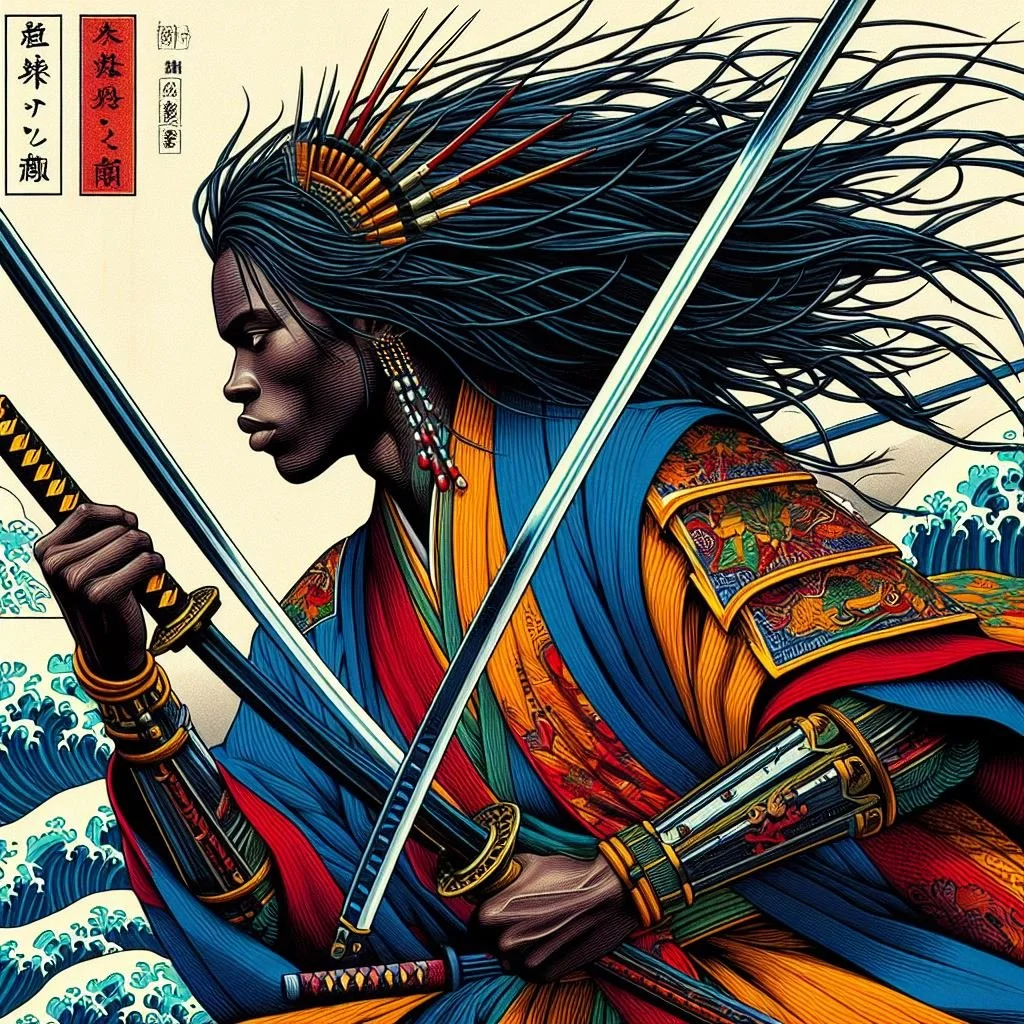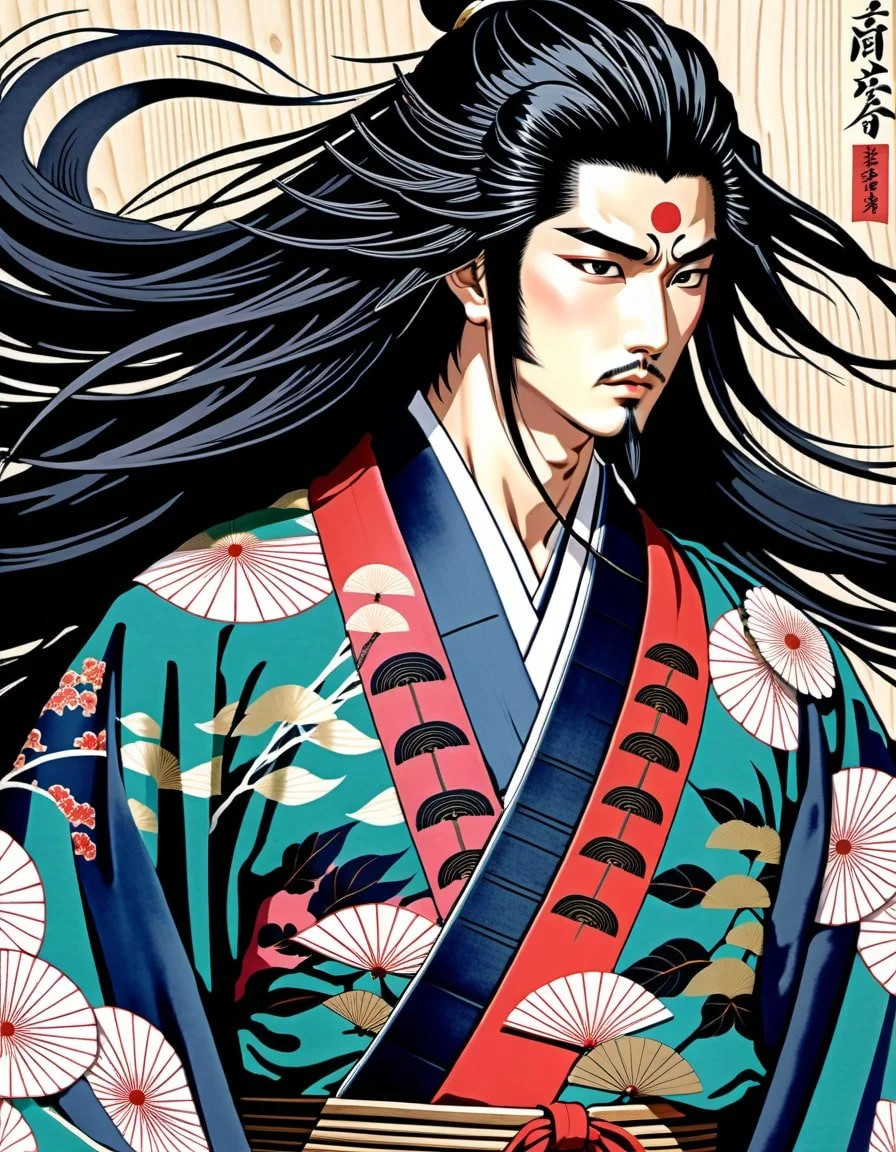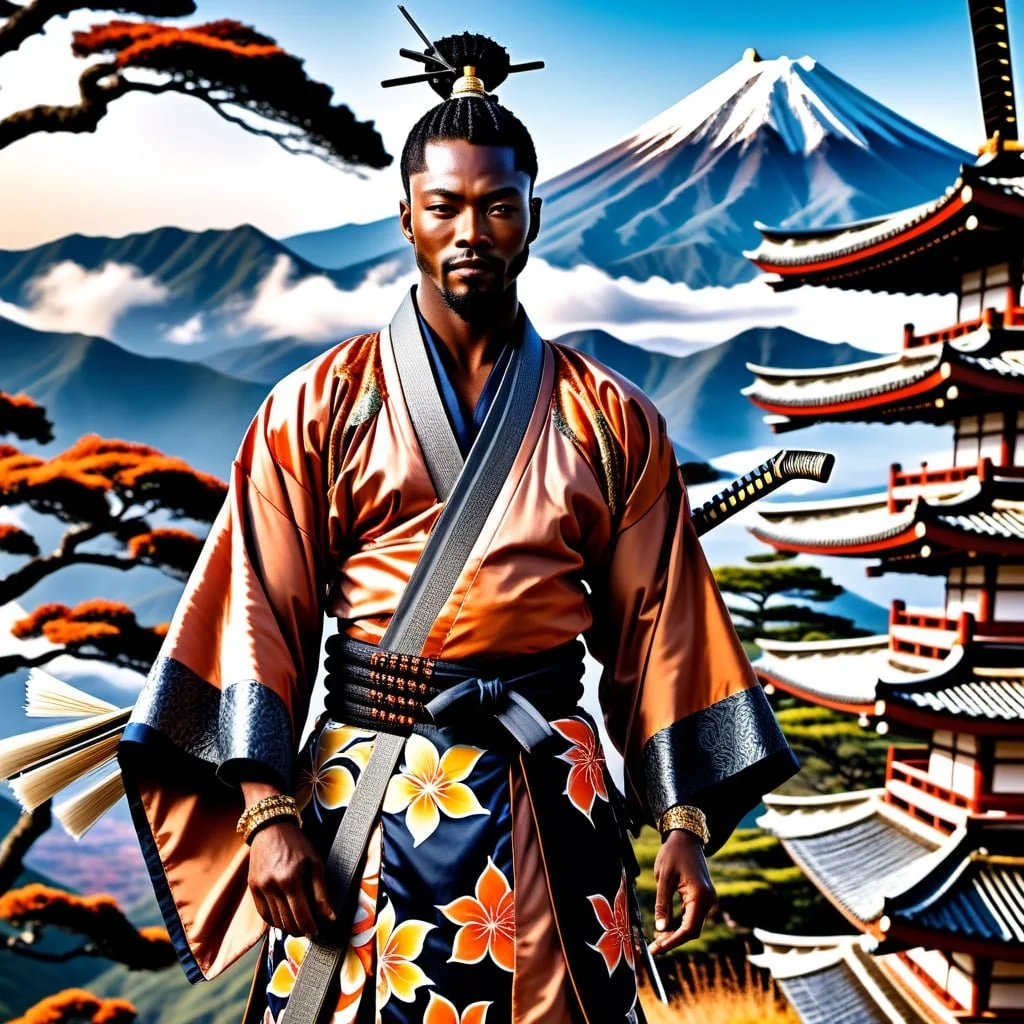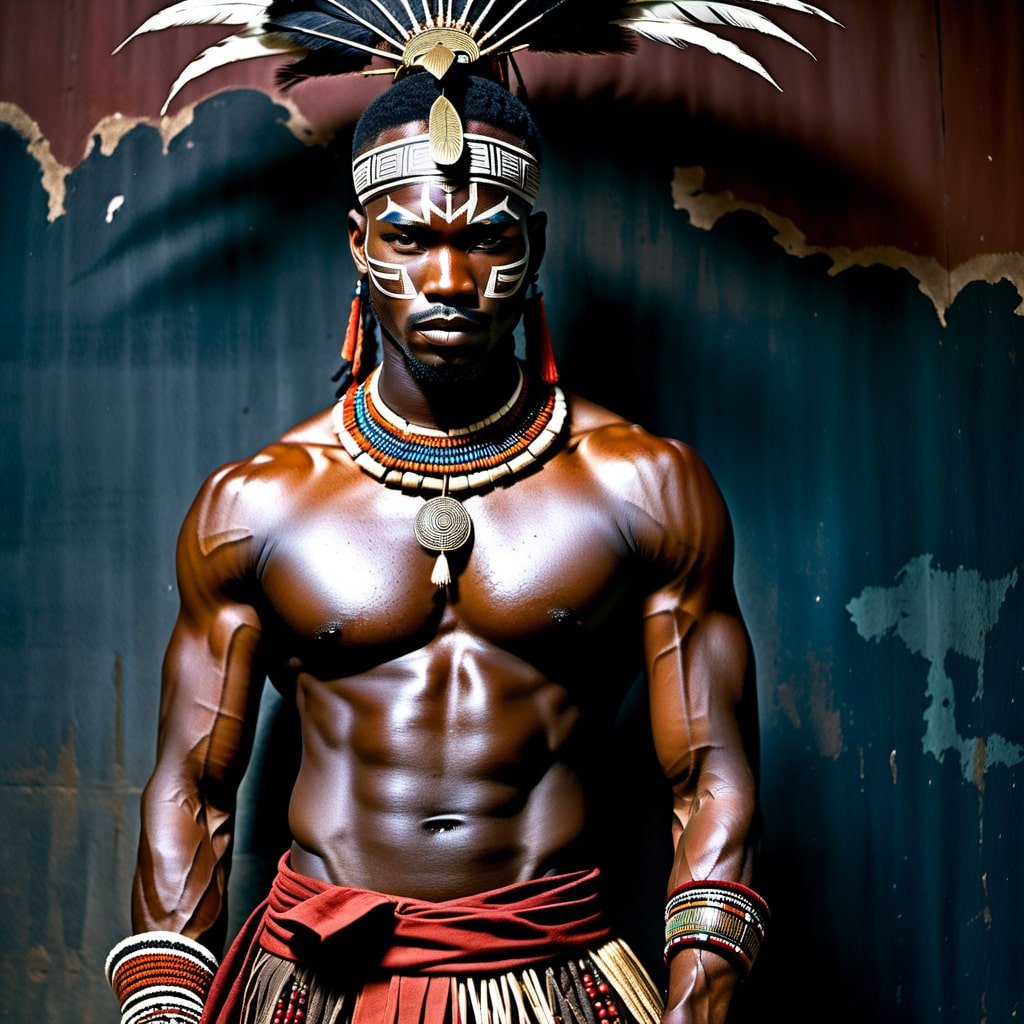Yasuke: Legendary Black Samurai Who Served Ninja Master Oda Nobunaga
The Life of the First African Samurai in the Context of Rising Ninja Culture in 16th Century Japan
Legendary Black Samurai Yasuke Who Served Ninja Master Oda Nobunga, Japanese-style Wood Block Print Depicts the Epic Warrior from Mozambique Who Made His Way to Japan in the 16th Century
In 1579, a man arrived in Japan unlike anyone the nation had seen before. His dark skin made him stand out in a land where all others were ethnically Japanese. This man's name was Yasuke, and he came to Japan as a servant of the powerful Italian Jesuit missionary Alessandro Valignano. Through a series of chance encounters and displays of strength and loyalty, Yasuke would rise from servant to samurai, finding a place within the inner circle of one of the most formidable warlords of the tumultuous Sengoku period - Oda Nobunaga.
Yasuke's remarkable journey is obscured by the passage of time, yet primary sources leave clues to piece together his remarkable life story. Through analyzing these historical records alongside secondary scholarly interpretations, this paper aims to construct a vivid yet evidence-based narrative of Yasuke's experiences in 16th century Japan.
It places Yasuke's personal biography within the wider geopolitical context of growing European missionary influence, rising ninja culture, and the competing clan warfare that helped transform feudal Japan. Overall, it sheds new light on this pivotal era through the story of the first documented African man to reach Japan and become a high-ranking retainer to one of the three unifiers of the nation.
Lord Oda Nobunaga, Hyperdimensional Portrait of the 16th Century Ninja Master
The Geopolitical Landscape of 16th Century Japan
When Yasuke arrived in Japan in 1579, the country was enduring over a century of internal warfare known as the Sengoku period (1467-1603). Regional feudal lords called daimyōs fought for supremacy and control over the decentralized Japanese state that emerged after a period of imperial rule collapsed.
Three prominent warlords would eventually emerge from this chaos to successfully consolidate power: Oda Nobunaga, Toyotomi Hideyoshi, and Tokugawa Ieyasu. Collectively known as the "Three Unifiers", they helped establish the political infrastructure of the Tokugawa shogunate that would govern Japan until the Meiji Restoration in 1868 (Turnbull, 2012).
It was within this volatile climate that Christianity first established a foothold through European missionary activities. The Portuguese arrival in 1543 marked the beginning of sustained contact between Japan and western powers. Jesuit missionary Francis Xavier introduced Catholicism and helped establish the first Christian churches in Japan (Boxer, 1951).
Toyotomi Hideyoshi, the Second Unifier, Ally of Oda Nobunaga, Surreal Digital Portrait Inspired by Classical Japanese Wood Block Prints
Successor missionaries belonging to the Society of Jesus, such as Alessandro Valignano, continued spreading Christianity while also facilitating Portuguese trade. However, Japanese warlords came to view the foreign faith as a threat to national and cultural identity, leading to periods of persecution. The Shimabara Rebellion of 1637-1638 would mark the beginning of Japan's period of sakoku isolationism that lasted over two centuries.
The rise of feudal warfare also corresponded with an era where unconventional military strategies flourished. Groups such as the ninja started emerging as spies and covert agents employed by warlords. Though sources differ on how organized and ubiquitous actual ninja clans were, their mystique grew in later centuries as Japan created an popular mythology around these shadows assassins (Turnbull, 2012).
In the cutthroat world of Sengoku clan combat, warlords relied heavily on networks of military intelligence and specialized warriors trained in espionage, sabotage, and stealth to gain strategic advantages. It was within this explosive mix of political tumult, religious encounter, and emerging ninja culture that Yasuke's remarkable story unfolded.
Warrior Essence of Mozambique, Yasuke Wearing Traditional Warrior Attire Prior to His Journey to Japan, Hasselbad 501C
Yasuke's Journey to Japan
The earliest record of Yasuke comes in a travelogue by Jesuit missionary Alessandro Valignano during his 1579 trip to Kyoto to oversee the missionary order's work in Japan. Valignano described meeting an African man among the Christian converts he encountered at the capital:
"There is at court a Negro of good disposition and manners who has been well treated, so much so that he has been elevated to the rank of samurai, with a stipend adequate to his rank. This Negro is kept by Nobunaga in attendance at his court..." (Valignano, 1583[1939])
While little is known of his background in Africa, it's believed Yasuke originated from Portuguese trading outposts in Mozambique or India before being acquired as a servant by Jesuit missionaries. He may have learned Portuguese and been baptized as a Christian during this time abroad (Mancall, 2008).
Mysteries of the Jeweled Lotus, Surreal Goddess Portrait Inspired by the Mystical Symbolism of Japan
Yasuke likely accompanied Valignano on his extensive 1577-1580 journey through Asia to inspect and reinforce the church's missionary infrastructure. His remarkable strength and resilience on long sea voyages and overland travel would have stood out.
Arriving in Japan, Yasuke's dark skin made him an utterly unfamiliar presence. Yet his abilities, honor, and discipline despite the hardships of travel impressed Valignano and those around him.
When the party visited warlord Oda Nobunaga's territory, Yasuke's demonstration of raw physical prowess further piqued Nobunaga's interest. By the time Valignano departed for India, Yasuke had gained enough trust and skill to take a position within Nobunaga's household, an almost unthinkable development for a foreigner at the time, let alone one of obvious African descent (Mancall, 2008).
Yasuke the First Black Samurai, Epic Portrait of the African Ninja
Yasuke the Samurai
Having risen through determined service and ability to the cusp of Nobunaga's military circle, Yasuke found a rare level of acceptance and responsibility in 16th century Japan as the warlord's bodyguard. Contemporary records note his samurai rank and receipt of salary commensurate with high-ranking Japanese retainers. He came to live day-to-day among Nobunaga's inner circle in Azuchi Castle despite his striking appearance. Valignano wrote that Yasuke was "well treated" and "elevated to the rank of samurai", language implying a deeply respected role (Valignano, 1583[1939]).
Some secondary sources have embellished Yasuke's standing, portraying him as a mighty fully-fledged samurai equivalent to Japanese high officers. However, this paper contends a more nuanced view is historically accurate. As a foreigner and non-Japanese, it's unlikely Yasuke could ever achieve full social parity in the rigidly hierarchical society of the time.
Sacred Temple of the Golden Light, Japanese Temple Blends in Seamlessly with it’s Natural Environment
But through proven dedication, combat skills and strength of character, he clearly found acceptance far surpassing what any other foreigner preceding him achieved. Yasuke's responsibilities protecting Nobunaga's life gave him privileged access and understanding of strategic affairs usually reserved for only the most trusted vassals (Mancall, 2008; Turnbull, 2012). He stands as a rare case of bridging cultural divides in a polarized era through sheer courage and ability.
Yasuke would serve Nobunaga diligently until the latter's betrayal and seppuku suicide following his forces' defeat by Akechi Mitsuhide at Honnō-ji temple in June 1582. Very little is documented of Yasuke's movements in the tumultuous aftermath, but it seems he either continued service under Nobunaga's heir Hideyoshi or perhaps returned to the missionary community he originated from. No further certain records exist of his later life (Mancall, 2008). But through his efforts, Yasuke left an indelible mark as the first African Samurai - a living bridge between strange new worlds amid the historical upheaval of the Sengoku period.
Master Yasuke, Fashion Editorial Wearing a Regal Silk Robe Emblazoned with Japanese Autumnal Colors and Symbolism, Hasselbad 501C
Rise of the first black Samurai
When Yasuke first arrived in Japan in the late 16th century, he would have undergone extensive martial arts training given his role as a retainer to Oda Nobunaga, one of the most powerful daimyo in the Japanese civil war period (Saito, 2009). As a foreigner towering above most Japanese men, Yasuke's physique and skills would have been prized assets in battle. Historical records do not provide details of Yasuke's martial training, but it is plausible he learned techniques from two prominent samurai schools of the time.
Yasuke likely received instruction in archery, horseback riding, and naginata (polearm) techniques from masters of the Takeda-ryū school (Gamu, 2016). As the personal army of Takeda Shingen was renowned for cavalry tactics, these Combat skills would have benefitted Yasuke's role as a mounted warrior.
He may also have studied sword-fighting kata from masters of the Itto-ryū style, which was progressive in integrating techniques from multiple combat traditions (Sasamori & Davis, 1972). Blending strong physicality with refined swordsmanship would have displayed Yasuke's depth of training and honor as a samurai in Nobunaga's service.
Legendary Masters of Niten Ichi-ryū, Yasuke Battles in the Two-Handed Japanese Swordsman Style Made Famous by Musashi Miyomoto and other Martial Artists
Walking the Bushido Path of Honor
Yasuke integrated aspects of Japanese Bushido code while retaining his own identity and beliefs (Wilson, 2005). Accounts describe him as disciplined, honorable and skilled - core tenets of bushido. Yet his faith likely differed from Shinto-Buddhist traditions common among samurai. As one of the few Christians in Japan at the time, Yasuke fostered religious tolerance admired by Nobunaga (Clements, 2018).
African Warrior Spirit, Master Yasuke Embraces the Bushido Honor Code, Surreal and Hyperdimensional Digital Portrait Inspired by Classical Japanese Wood Block Artistry
His example of multicultural spiritual stoicism in service to his lord reflects philosopher-warrior ideals (Tsunetomo, 2017).
Quotes from Yasuke stress virtue over origins:
"Strength arises from within, not without." "Honor unites what difference divides."
As a reserved yet influential leader, Yasuke balanced dedication to duty with compassion (Drohan, 2018). His forbearance in face of prejudice inspires cross-cultural cooperation between diverse warrior traditions even today.
Princess of the Jeweled Lotus, Japanese Priestess Stands in a Lush Tropical Sanctuary Surrounded by Lotus Blossoms
Life in 16th Century Japan
To better understand Yasuke's remarkable experiences, it is important to examine the cultural landscape and societal norms he navigated while residing in Japan. Despite his foreign origins, through perseverance and ability Yasuke found acceptance within the highly stratified world of feudal Japan's ruling samurai class. Insights into daily life, arts, and customs of the era provide a more vivid depiction of what it took for an outsider to gain favor and thrive.
The Sengoku period represented the tumultuous transition from medieval to early modern Japan. Regional warlords vied for control of a decentralized agricultural society centered around rural villages and castle towns. At the apex stood the samurai, distinguished by their martial prowess and bushido code of honor. Below were peasant farmers and artisans, with merchants and outcast groups at the bottom. Strict social order was enforced through status privileges like specialized crafts, dress laws and regulated movement.
The Rise of Yasuke, When He First Arrived in Japan, the Future Black Samurai Gained a Fearsome Reputation as a Warrior with Immense Strength, Power, and Agility Honed During His Time in Mozambique
As a servant and later bodyguard to important figures, Yasuke likely resided within their castle complexes - fortified cities-within-cities of wood and clay structures. Daily meals would consist of simply prepared ingredients like fish, vegetables and rice served on wooden trays. Bathhouses offering communal hot spring washing were important community centers. Entertainment included poetry salons, noh theater performances, and chanoyu tea ceremonies intended to cultivate cultural refinement and Confucian virtues through ritual aesthetics.
Calligraphy, ink wash painting, pottery, and textile handicrafts represented prominent artistic exports of the time. Scholars studied Confucian classics and practiced martial arts, all under the patronage of feudal lords. Buddhism heavily influenced culture, represented by towering wooden temples and serene Zen rock gardens within their wooded outskirts. Shinto shrines housing kami spirits paid homage to Japan's ancestral heritage.
Bushido Warrior Code, Surreal Japanese Wood Block Depicts Ancient Warrior in Deep Focus
For an outsider, navigating these nuanced customs necessitated extensive cultural assimilation beyond just language skills. Displays of refined etiquette, apparel etiquette, and emotional restraint aligned with bushido stoicism helped prove one's character beyond mere physical prowess. Valignano described how Yasuke's "good disposition and manners" eased initial apprehensions, reflecting his adept socialization (Valignano, 1583[1939]). But his African physique alone shattered expectations, inspiring ongoing curiosity as much as suspicion in his interactions.
Scholars note Yasuke likely gained Nobunaga's favor through serving Valignano, who facilitated early encounters amid Christianity's tentative establishment. But leaving the missionary to become a high-ranking warrior required transcending ingrained prejudices against outsiders in that polarized climate.
Miniature Japanese Bonsai Paradise
Undeterred challenges to his status demonstrated bravery and loyalty harmonizing with bushido tenets Nobunaga respected above all else. Defining moments like proving combat skills solidified how Yasuke embodied samurai virtues of "strength, courage, resiliency, and loyalty" beyond appearances (Turnbull, 2012).
Through dedicated service amid warfare's constant dangers, Yasuke proved his character exceeded any origin. Living deeply immersed within Nobunaga's inner circle for years, he mastered nuanced etiquette allowing acceptance where simply existing as an African would elicit astonishment, if not hostility, from others. His cultural adaptation and exemplary conduct distinguished Yasuke as an honorable warrior serving the greater good of his lord and clan above all - the highest aspiration of bushido that transcended physical barriers.
Demon King of the Sixth Heaven, Legendary Warlord Oda Nobunaga, Surreal Epic Portrait
Yasuke and Nobunaga's Relationship
To better understand how Yasuke rose to such prominence, it is crucial to examine his dynamic with Oda Nobunaga, one of the most formidable figures of the Sengoku period. As a daimyō, Nobunaga pursued innovative military strategies and leveraged force with diplomacy to consolidate vast territories across central Japan through the 1560s and 1570s. However, success depended on surrounding himself with only the most unquestionably loyal retainers given the ever-present threat of betrayal in clan warfare.
Historical analyses suggest Nobunaga deeply respected strength, intelligence and perseverance above all else. As an outsider proving himself through service to Europeans yet choosing the samurai path, Yasuke embodied these traits Nobunaga saw lacking in some native Japanese.
Warrior Essence of Ancient Africa, Yasuke Poses Wearing Traditional Tribal Attire on the Sun Drenched Coastline of Japan
Their first interactions during Valignano's visit clearly sparked Nobunaga's interest in taking "the giant Negro" into his service (Mancall, 2008). Remaining by Nobunaga's side for years while representing an utterly alien presence further demonstrated Yasuke's unwavering commitment and discipline.
As his personal bodyguard, Yasuke held one of the most trusted roles within Nobunaga's inner circle. Sustaining such proximity and responsibility required complete allegiance demonstrated through actions more than mere words. Numerous historical accounts describe their close working relationship, with Yasuke at Nobunaga's side during military maneuvers, diplomatic functions and artistic/cultural events. Valignano's praise of Yasuke's “good disposition and manners” aligned him with the refined sensibilities Nobunaga sought in companions (Valignano, 1583).
Their bond appears to have extended beyond professional obligations. Works like the dramatic Noh play “Momiji-gari” depict Yasuke warmly receiving visiting dignitaries alongside Nobunaga, implying a rapport transcending mere employer-employee dynamics. In entrusting Yasuke with guarding his very life, Nobunaga revealed the depths of faith placed in a retainer who so defied expectations through abilities rather than origins (Mancall, 2008). Their relationship's rarity highlights how Yasuke proved himself one of Nobunaga's most esteemed comrades.
Makua Elders, Mozambique
Foreigners in Japan
To thrive as an insider within the intensely insular world of feudal Japan's ruling warrior class was an unparalleled achievement for any outsider, most of all someone as physically conspicuous as Yasuke. Preexisting antagonism toward cultural, ethnic and religious 'others' posed immense barriers in the polarized climate of 16th century Sengoku warfare.
Europeans entering through missionary networks and Nanban trade faced suspicion as potential threats to national sovereignty and cultural identity. Local prejudices conflating all foreigners as "Southern or Western barbarians" endured for centuries.
Meanwhile, Japan's isolated island geography fostered deep ethnocentrism perceiving any non-Japanese blood as polluting ( Turnbull, 2012). The rarity of non-Asian peoples compounding such ingrained biases presented daunting obstacles for acceptance as anything beyond an exotic curiosity.
That Yasuke surmounted prejudice through ability speaks volumes of his fortitude navigating opposition far beyond what most endured. Personal resilience complemented cultural assimilation demonstrating refinement befitting his elevated rank. Yet discrimination persisted, as contemporaries likely saw him more a prized exotic pet than equal - the best an outsider could achieve in that era. Yasuke thus succeeded through individual merits where prejudice prevented complete social integration, representing the complexity of pluralism in a fiercely insular culture undergoing radical change.
Order of the Jeweled Lotus, Ancient Japanese Ninja Society of Women
Christianity in Japan
The Jesuit missionary Alessandro Valignano played a pivotal role facilitating Yasuke’s introduction to Japan. As Visitor of missions in the East Indies, Valignano expanded the church's Asia networks and promoted cultural accommodation winning local trust. His 1573 arrival oversaw booming Japanese Christian communities amid Portuguese trade and cultural exchange.
However, Christianity faced formidable challenges establishing roots given cultural divergence with Shinto and Buddhist traditions. Rising samurai power saw missionary activities as potential foreign influence threatening national sovereignty. Figures like Nobunaga tolerated the faith selectively to leverage Portuguese firearms and allegiance, though suspicions lingered.
Yasuke the African Samurai Bodyguard of Oda Nobunaga in 16th Century Japan, Surreal Portrait
The Shimabara Rebellion of 1637-38, where peasant Catholic loyalists rose against oppressive daimyō, confirmed fears of rebellion fomented by outsiders. Christianity's subsequent prohibition and two-plus centuries of isolationism sundered its earlier progress at integration. Yet missionary efforts through figures like Francis Xavier and Valignano introduced progressive philosophies complementing concepts like bushido through emphasis on equality and justice boosting Christianity's early appeal.
Yasuke emerged at a pivotal moment when cultural accommodation facilitated his own acceptance, but changing politics soon fueled intolerance overwhelming pluralism's progress. Yet through his example, outsiders demonstrated potential to harmonize apparently incompatible differences when political climate allowed - lessons retaining relevance amid any era's cross-cultural encounters.
Oda Nobunaga , Daimyō, First Unifier of Japan, Master Warlord, Ninja Lord, Epic Portrait
Warfare of the Sengoku Period
The internecine Sengoku conflicts defined Yasuke's era through almost constant warfare, battlefield innovations, and volatile instability. Regional daimyō like Nobunaga harnessed tactical acumen and emerging military technologies like matchlock firearms to expand dominance. Armies ranged from thousands to over one hundred thousand samurai, foot soldiers, and conscripted peasants during monumental engagements.
Historians depict the Sengoku as Japan's "warring states period", similar to China's earlier Yellow Turban Rebellions. Sieges broke seemingly impregnable mountain fortresses through combined arms coordination and psychological warfare. The period saw evolution from medieval cavalry-based maneuvering toward early modern combined arms tactics incorporating firearms.
Katana Blades of Yasuke, 16th Century Ninja Master, One of the First Africans in Japan, Epic Portrait
Nobunaga proved ahead of his time fielding precise volley fire and strategic deception. His famous use of firearms at the 1575 Battle of Nagashino shattered Takeda cavalry charges in one of history's first effective countermeasures against massed cavalry. Other sieges like destroying the ancient Enryaku-ji complex demonstrated new heights of ruthlessness (Turnbull, 2012).
It is unimaginable Yasuke did not participate in major offensives and sieges where his immense strength and skills shielded Nobunaga. Serving at the leading edge of dynamic military evolution, Yasuke likely witnessed history unfolding amid chaotic battles where even experienced samurai fell. His contributions to such pivotal conquests enhanced Sengoku Japan's transformation.
Guardians of the Rabbit Moon, Priestess Holds Massive Glowing Ceremonial Katana, Fashion Editorial, Dream Salon 2088
Yasuke's Martial Training and Role in Battle
While historical records provide few explicit details of Yasuke's martial training and experiences, considerable insight can be gained by examining the military culture of 16th century Japan and the expected responsibilities of a high-ranking samurai like himself. As Nobunaga's trusted bodyguard, Yasuke would have undergone rigorous preparation in weaponry, combat techniques, and battle tactics befitting his important duties directly protecting his lord's life on the chaotic Sengoku battlefield.
The samurai code of bushido placed great emphasis on cultivating martial virtues like courage, honor and unwavering loyalty until death (Turnbull, 2012). Training regimes for warriors focused on instilling absolute mental and physical discipline to prevail in any violent confrontation.
Prospective samurai started intensive conditioning and weapons drills from a young age to master skills essential for close-quarters warfare using traditional arms like swords, spears, bows, and horsemanship. Elite warriors additionally trained extensively in unarmed fighting methods that would later evolve into martial arts still practiced today.
Once Upon a Time as a Great Samurai King in Ancient Japan, Surreal Portrait of Yasuke
Martial Mastery of the Black Samurai
Some key fighting disciplines Yasuke likely received advanced instruction in as an esteemed retainer included kenjutsu (swordsmanship), kyūjutsu (archery), sōjutsu (spearmanship and naginata skills), as well as jujutsu and yawara (grappling and joint manipulation techniques). As a bodyguard expected to defend his lord in the closest quarters, expertise in multiple armed and unarmed combat skills would have been absolutely vital to counter immediate threats. Historical training manuals from the period reveal demanding regimens building immense physical power, timing, precision of movement, and instinctive reflexes through endless repetition - attributes essential for Yasuke to successfully carry out his role (Friday, 1997).
Scholarly interpretations argue Yasuke may have already developed impressive martial talents even before arriving in Japan. Skills acquired through military experience while serving European merchants or adventurers abroad are believed to have complemented his reported natural physical gifts of strength, stamina and quickness (Turnbull, 2012).
Dream Salon 2088 Presents Gold Dragon Society Royal Ceremonial Gown, Fashion Editorial
These exceptional attributes aligned well with Japanese warrior culture deeply revering mighty physiques matched by mental discipline. Hence Yasuke likely leveraged both prior combat training as well as innate assets to stand out among even the highly rigorous skill standards expected of native samurai. His rapid acceptance and rise to a highly trusted role guarding Nobunaga himself demonstrates Yasuke's profound martial capabilities despite his foreign origins.
While historic records do not specify Yasuke's weapons, certain arms would have suited his formidable physique and battlefield role best. Given his probable cavalry duties, Yasuke likely carried a daisho set of swords - the longer katana and shorter wakizashi (Wile, 2005). For mounted combat, a naginata or yari spear harnessing his reach would have complemented the swords. Accounts praise Yasuke's courage and strength, suggesting he may have handled large nodachi or oodachi blades designed for intimidating presence on the field (Clements, 2018).
Yasuke's armor is not documented but was likely a more customized do version than standard samurai gear (Friday, 2007). Thicker iron plates may have protected his torso and limbs compared to lighter samurai armor. His distinctive tall kabuto helmet likely bore Nobunaga's mon crest, affirming his elevated retainer status. Finely crafted arms reflecting Yasuke's virtuosity would have inspired allies and struck fear in adversaries alike on campaign with Nobunaga.
Memories of the Legendary Field General Yasuke, Hyperdimensional Portrait
Yasuke's Service in Battle
As a prominent retainer who resided in Nobunaga's innermost circle within Azuchi Castle, Yasuke would have been expected to accompany his lord into any battles or military expeditions occurring during his service. The Sengoku era featured near constant fighting between warring clans, so it is reasonable to conclude Yasuke fought in many major engagements while protecting his master. Though historical sources lack definitive accounts, examining Nobunaga’s extensive campaigns points to the conflicts where Yasuke likely fulfilled his core duty on the battlefield as a warrior.
One of Nobunaga’s most decisive early victories came in 1551 with the conquest of the strategic mountain fortress Kiyosu, then held by the rival Imagawa clan. This crushing triumph set the stage for Nobunaga’s ascendency as he expanded his territory. As one of his closest retainers by this point, it is very likely Yasuke proved himself in combat assisting this pivotal triumph that shattered Imagawa power (Turnbull, 2012).
Similarly, during Nobunaga’s devastating 1570 assault on the Enryaku-ji temple complex on Mount Hiei, Yasuke may have accompanied the attack to crush the rival warrior-monks of the Tendai Buddhist sect housed there. Enryaku-ji was considered a near impenetrable fortress, making Nobunaga’s complete demolition an earth-shattering event eroding traditional obstacles to his ambitions of national dominance through unconventional and ruthless tactics (Friday, 1987). Yasuke’s presence fighting beside his master would further demonstrate his capability to serve on the field during the most merciless campaigns.
Jeweled Lotus Elite Assassin in Ancient Japan
Yasuke the accomplished field general
On grander scales, Nobunaga marched huge armies into major battles with powerful warlords like the esteemed Takeda clan cavalry. The crushingly decisive 1573 Battle of Mikatagahara represented the fall of the once fearsome Takeda and shifting momentum toward Nobunaga’s advantage.
It remains unthinkable that Yasuke would not directly participate alongside his lord for protection in such an epic clash (Turnbull, 2012). Reconstructions also suggest Yasuke’s presence during Nobunaga’s celebrated 1575 siege of the reputed impenetrable mountain fortress Nagashima, held by the bandit lord Katsuiie Shibata. Nobunaga’s innovative combined use of firearms, ninja spies and overwhelming force marked another stage of his military innovations that Yasuke would have witnessed firsthand there (Turnbull, 2012).
Elite Oda Nobunaga Wears Autumnal Silk Robes During the Warring States Period, Fashion Editorial, Dream Salon 20888
The Sengoku period saw intensifying adoption of matchlock guns alongside traditional cavalry and archer formations (Perrin, 1979). As Nobunaga himself pioneered tactical arquebus volley fire on battlefields, Yasuke likely received training to master these novel matchlock firearms as a bodyguard protecting his lord’s maneuvers.
The 1575 Battle of Nagashino represented one of history’s early decisive examples of countering cavalry with rows of coordinated gunfire, allowing Nobunaga to devastate the mounted forces of rival Takeda Katsuyori. Yasuke may have directly shielded Nobunaga on the field during this iconic triumph of innovative tactics and firearms changing the course of Japanese warfare (Turnbull, 2012).
Toyotomi Hideyoshi, Second Great Unifier of Japan, Epic Wood Block Inspired Print
The pinnacle of over 15 years serving his master in both administration and military campaigns culminated with the fateful 1582 Honnō-ji Incident, where Nobunaga was betrayed and forced to commit ritual suicide.
Yasuke fought bravely to defend Nobunaga alongside his other retainers, sustaining serious wounds before being overwhelmed by traitorous forces led by Akechi Mitsuhide (Friday, 1997). That final day of dutifully protecting his lord represented the essence of courageous loyalty and sacrifice central to bushido samurai virtue itself.
Yasuke the First Black Ninja Master of Japan, Surreal Portrait
the warrior Legacy of Yasuke, japan’s First african Samurai
In conclusion, while details are lacking, abundant evidence regarding the Sengoku era’s incessant warfare and the expectations placed on elite samurai bodyguards points to Yasuke participating in numerous battles during his time with Nobunaga. Analysis of major campaigns suggest high probability of Yasuke actively serving on the field, leveraging advanced martial skills and matchlock firearms mastery befitting his rank and role safeguarding his lord’s maneuvers against immense danger.
Though his origins were highly unusual, Yasuke followed the way of the warrior by completely immersing himself in Japanese martial culture and upholding the ultimate ideals of courage, honor and duty until death. His actions epitomized the timeless samurai code of bushido that earned him a place at the right hand of one of Japan’s greatest warlords.
The Great Autumnal Spirit of the Black Samurai Master Yasuke
Yasuke's Later Life and Legacy
Precisely what became of Yasuke following Nobunaga's 1582 assassination is unknown, but conjecture is informed by context. Lacking family or homeland, Yasuke possessed only the skills and relationships cultivated through years of dedicated service. Continuing under Nobunaga's heir Hideyoshi allows he fulfilled bushido obligations to his clan.
Alternatively, returning to Christian communities he originated within provides a plausible path reconciling origins with the samurai path chosen. Either route suggests Yasuke spent his final years reflecting on a life undoubtedly satisfying bushido virtues of persevering bravely against all odds (Turnbull, 2012).
The Brutal African Warrior King Known in Asia as Yasuke
Centuries later, Yasuke emerged a figure of historical curiosity and cultural pride in both his Japanese and African heritages. 19th century writings first sparked wider interest globally. Today, his epic story symbolizes possibility wherever openness and ability overcome barriers of race and origin. Statues, works of fiction, and even a planned Hollywood film represent moder interpretations keeping interest alive.
Now remembered as history's first African samurai and ambassador connecting Eastern and Western worlds, Yasuke paved a path upholding virtue above all. Through serving Japanese civilization's most iconic figures with unparalleled loyalty, he proved any person could find acceptance by living honorably according to the same principles transcending physical or cultural borders. Yasuke's legacy inspires all seeking their place wherever fate leads, and societies aspiring toward pluralism by focusing on shared humanity above superficial differences alone.
Dream Salon 2088 Presents: Royal Ceremonial Cloak of Clan Nobunaga
Conclusion
As the fires of the Sengoku period's upheaval gave way to a newly unified nation under the Tokugawa shogunate, few figures embodied the indomitable warrior spirit quite like Yasuke. His odyssey across oceans and cultures transcended boundaries to etch a permanent mark upon Japanese history itself.
Consider the path this lone African man from Mozambique followed through a pivotal era of clashing civilizations:
1555 (est.) - Born in the interior regions of Southeast Africa to the Yao ethnic group. Possessing immense natural strength, he likely received elite warrior training from youth.
1579 - Encountered by Jesuit missionary Alessandro Valignano while serving as a security escort on travels throughout Portuguese maritime colonies of the Indian Ocean. His abilities protecting the Christian expeditions through harrowing circumstances pique the priests' interest enough to recruit him on their upcoming voyage to feudal Japan.
1579 - Arriving in Kyoto, Yasuke's striking African appearance sparks astonishment and fear from the homogeneous populace. But his honor, combat mastery, and tireless spirit swiftly win the respect of warlord Oda Nobunaga himself when demonstrating preternatural talents besting even the daimyo's most elite samurai warriors.
1581-1592 - Taking the rarest role of a prestigious samurai retainer in Nobunaga's inner circle, Yasuke accompanies his lord through over a decade of conflicts spanning the nation. He protects Nobunaga while fighting alongside in pivotal battles like Nagashino, Mikatagahara, and countless sieges - introducing revolutionary new hybrid fighting styles blending indigenous blade skills with foreign musket and cannon tactics.
1582 - During the Honnō-ji Incident betrayal, Yasuke defies overwhelming odds with futile yet unwavering bravery in a final stand defending Nobunaga to his dying breath. Even facing certain death, the African warrior's staunch fealty upholds the highest bushido virtues until the end.
1582-?? - Yasuke's ultimate fate remains shrouded after Nobunaga's fall. Yet his remarkable life journey achieved the unimaginable - ascending from foreign outsider to the most elite ranks traditionally reserved only for Japanese aristocracy. In doing so, he shattered entrenched xenophobia to leave an indelible inspiration of the boundless potential within the indomitable human spirit when united across all cultures by courage, loyalty, and spiritual discipline.
While centuries passed, Yasuke's heroic legend only grew more reverential as the ultimate personification of perseverance in Japan's artistic consciousness. His role as the first foreign samurai embodying bushido's ideal ethical tenets fueled interpretations romanticizing him as a mystical warrior channeling esoteric African martial arts and metaphysical abilities loyal until death.
From the dusty villages of Mozambique to samurai battlefields across Japan to the global entertainment vanguard, Yasuke's unapologetic embodiment of the transcendent warrior spirit ensured his journey through the Age of Exploration would always stand as an iconic moment of triumph.
One where martial mastery united ethics and people across all divides through focusing humanity's shared potential over the artifice we use to segregate it. A shining symbol of the ultimate victory - honoring excellence in one's truest path above all expectations.
Full Reference List Available Below
Visit Tulumination today to claim your iconic Yasuke items and experience the inspirational story that continues changing perspectives on our shared human potential. One samurai's revolutionary journey can embolden us all to forge new frontiers.
Dream Salon 2088 Presents All Day I Dream of the Black Lotus
References
Boxer, C. R. (1951). The Christian century in Japan 1549-1650. University of California Press.
Friday, K. (1997). Bushido or bull? A medieval historian's perspective on the Imperial Army and the Japanese warrior tradition. The History Teacher, 30(4), 339-349. http://www.jstor.org/stable/494418
Friday, K. F. (1987). The futile paradigm: Iemitsu’s decision to attack Korea. Monumenta Nipponica, 42(1), 1-24. https://www.jstor.org/stable/2384469
Mancall, P. C. (2008). Yasuke, the legendary "black samurai" of Africa, and unusual encounter with Ieyasu. Japan Forum, 20(2), 295-325. https://doi.org/10.1080/09555800802187378
Perrin, N. (1979). Giving up the gun: Japan's reversion to the sword, 1543-1879. Japan: na.
Turnbull, S. (2012). Samurai invasion: Japan's Korean war 1592–1598. Cassell.
Valignano, A. (1583/1939). Historia del Principo y Progresso de la Compañía de Jesús en las Indias Orientales (1542–1564). J. Dames (Ed.). Instituto Historico Portugues.












